
Porch Flooring
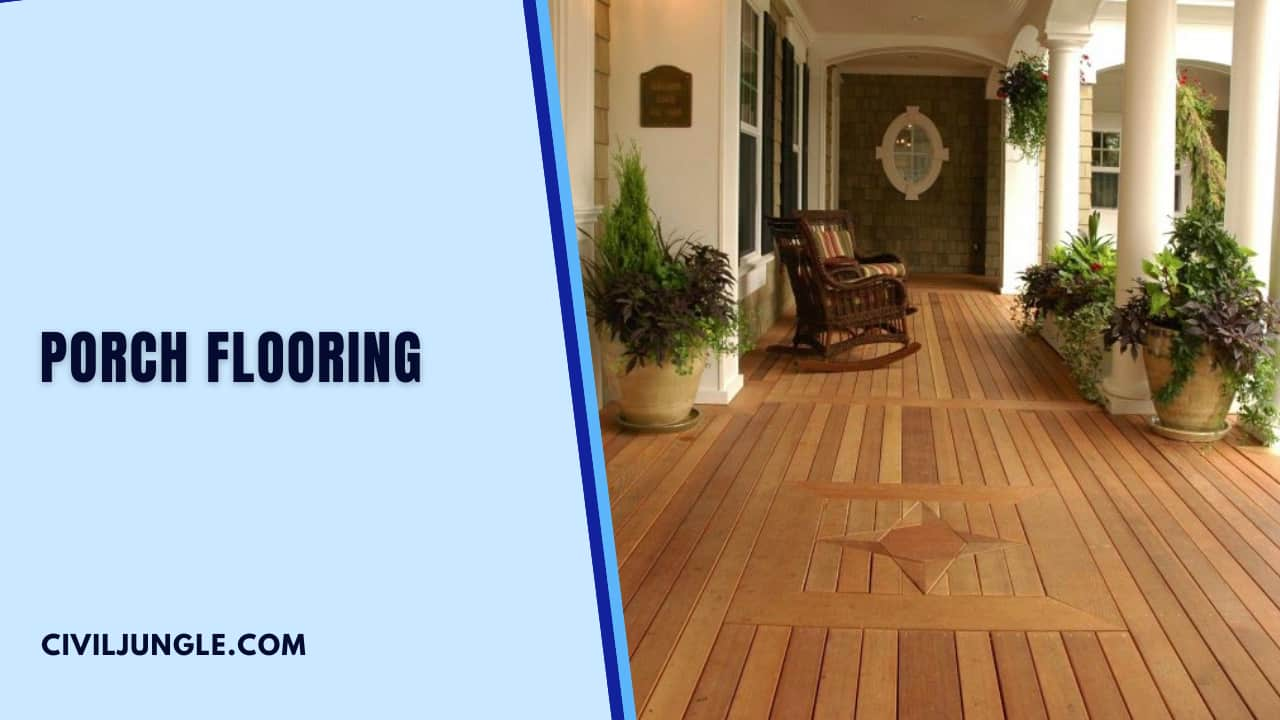
Whether you’re starting from scratch or giving an existing porch a facelift, flooring is a crucial consideration. There is no shortage of porch flooring designs, but you should give careful consideration before making a final decision.
A porch needs to be both comfortable and attractive. It adds visual interest to the exterior of the house and serves as a focal point.
Thus, the porch may have substantial economic consequences. When the appropriate front door is paired with an attractive porch, it can be a deal-maker.
However, if the porch has unsuitable flooring, prospective buyers may be dissuaded even before entering the house. There is also the problem of durability. Porch flooring can range from exceedingly durable (concrete, brick, or stone) to relatively low-maintenance (wood).
Expenses should be taken into account as well. Although blue stone is fairly pricey, it provides an opulent appearance that will last for many years to come.
Although it is long-lasting and relatively inexpensive, composite decking can’t compare to the natural beauty of wood. Staining real wood makes it inexpensive and full of character, but it also requires regular upkeep. Choosing porch flooring might be difficult.
Types of Porch Flooring
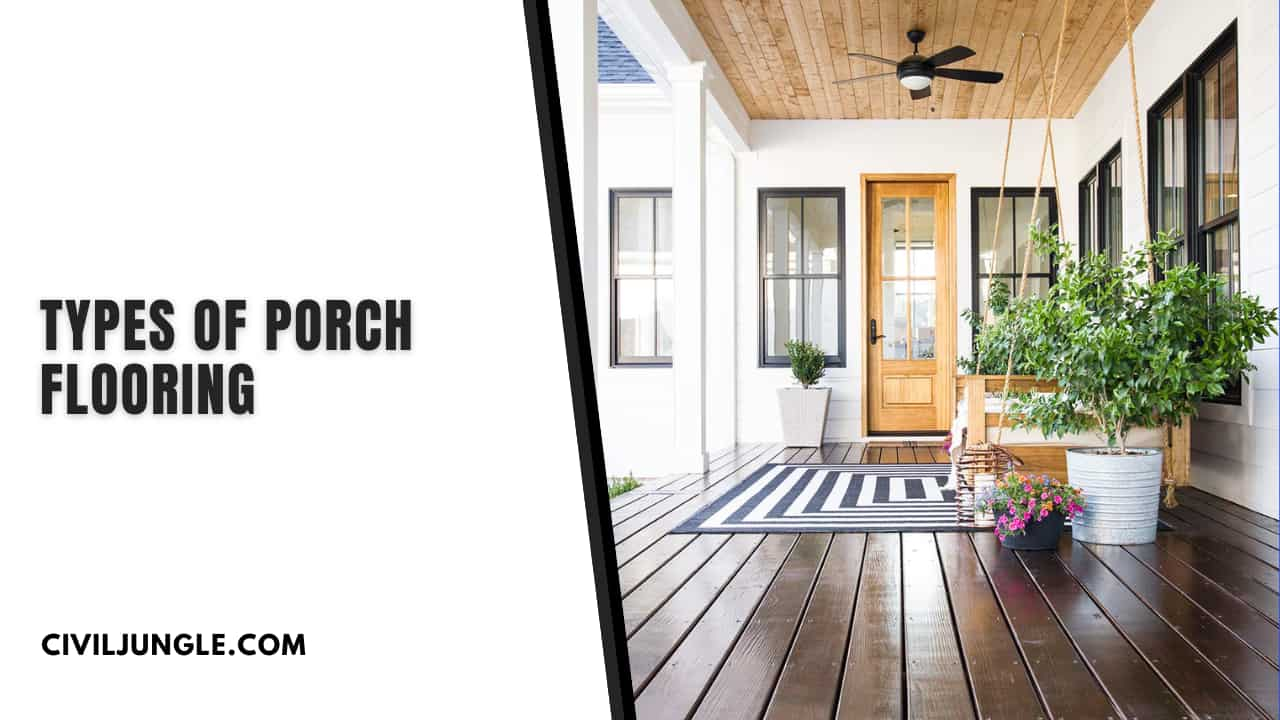
Only a select few types of porch flooring are truly worthy of consideration, and we’ll go over those in detail below. Which one you pick depends on your aesthetic preferences, your budget, the architectural style of your home, and whether you want masonry, wood, or composite.
1. Natural Stone Porch Flooring
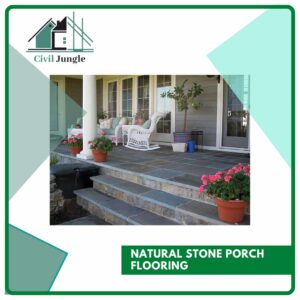
Stone is costly because of its high material and labor costs, but its beauty and durability are undeniable. The extra work involved in laying both the floor and the foundation of a stone porch adds up to a higher price tag.
Cement grout was used to install the floors seen above on top of a very strong compacted base. An experienced mason is needed for this arduous task.
Stone floor installation has always been a pleasant way to spend a day. I enjoy the challenge of assembling a puzzle from disparate parts. A lot of it is like piecing together a puzzle. On the other hand, laying the groundwork is a very different story.
The footings and walls of the foundation must be made of block or concrete. Installing a stone porch over a concrete slab is an additional costly and time-consuming step.
Stone flooring can be expensive, so it’s best to use it only for entryways or on very tiny porches. There is no low-cost way to accomplish this.
However, if you have the funds, it is a terrific flooring choice for the entry porches, which serve as a focal point as visitors enter and exit the building.
2. Front Porch Flooring Over Concrete
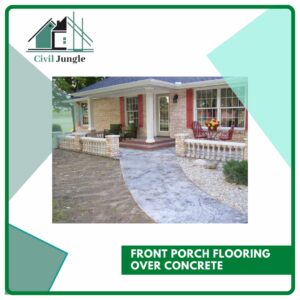
Rather than settling for the standard concrete, a stone porch floor is a step up in both style and durability. Thin slices of genuine stone can be purchased and installed as flooring. It’s simple to set up, just like tiling.
Cement and grout are what set natural stone apart when laid on concrete. Real stone is set in cement, not a thin layer of a thin set. Because natural stone is rarely perfectly smooth, the cement required is much heavier than when working with tile.
There are numerous holes and inconsistencies that need to be addressed. Real cement is required to fill the gaps since the grout lines are much larger and uneven.
Genuine stone flooring has many advantages over concrete, one of which is the relative ease with which stone may be sculpted. To get the forms you require, a rock hammer can be used instead of a knife.
If the porch is already made of concrete, installing stone flooring over it is not too expensive. If you have a concrete porch and want to update it, the stone is a terrific option. Although the stone is still costly, the concrete foundation has already been paid for.
Pick out the perfect hue and form for the house’s stones. Here’s a pro tip: when renovating a front concrete porch in preparation for a property flip, this is one of my favorite approaches.
Since the concrete foundation has already been poured, adding stone to the structure will not significantly increase the price. This is why the return on investment is so high.
3. Covered Front Porch Stone Flooring
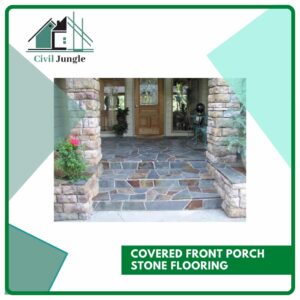
Covered front porches benefit greatly from stone slabs laid atop concrete. Stone flooring over the concrete porch is nearly impervious to water because of the porch’s sturdy build. If the porch is constructed correctly and any holes are sealed with cement, then the house will be safe from rain.
Even if the porch is covered, rain can still make its way onto the surface. Despite the presence of a roof, water can still be blown onto the porch and even into the house. A porch floor that is not damaged by rain, snow, and ice is a must. The use of stone in place of concrete is ideal in this situation.
If you want to keep water out of your house and have a stone porch over concrete, you need to do two things.
- Slope: Create a gentle downward slope from the house to the porch floor. The solidness of the ground prevents any seepage of water. Therefore, water will run in the direction that the floor is tilted. Verify that it is tilted away from the home.
- Seal: Seal the area where the porch joins the house to prevent water infiltration. The natural joint between the two pieces of rock will be filled with concrete, but the concrete will eventually split. Keep it tightly sealed to prevent water from entering and possibly damaging your home’s foundation. The use of silicone or tubed cement would be ideal here. Covered front porches with a stone-over-concrete floor are attractive and durable if they are constructed properly.
4. Blue Stone Porch Flooring

Putting a blue stone floor on your porch is a great idea. The actual stone used in its construction is extremely long-lasting. A siding color that complements its natural earth tones and bluish hues would look great on it.
The lack of smoothness on its surface when wet also makes it suitable for use as an outdoor flooring material. Due to widespread mining in states like Pennsylvania and Virginia, the United States is stocked with plenty of blue stone.
Because it doesn’t have to come from overseas, this helps keep prices down. With its high resistance to moisture and temperature changes, the blue stone is an excellent choice for a porch floor that is exposed to the elements year-round. It is widely used on the East Coast.
It is a traditional style for Hamptons houses. Like a brick porch, a blue stone porch typically consists of a footing, walls, and a soil or concrete central slab. Bluestone, like pavers, can be cemented into place or laid directly on a sand base. Cement grout lines are my preferred technique of installation.
The regularity of the blue stone’s shape and the sharpness of its cut edges are two of its best qualities. Finished like this, it looks just like tile.
Only this one is 100% all-natural. As for porch flooring, the blue stone is my absolute favorite. I think it’s worth it if you can afford it and the blue goes with your decor.
5. Blue Stone Pavers
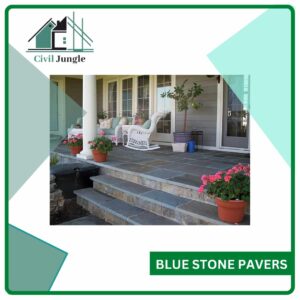
Some blue stones are imitations, just as bricks and other natural stones. Unlike genuine blue stone, blue stone pavers are far more affordable.
Its appearance won’t deceive anyone. It’s not quite the same as genuine blue stone, but it looks very similar and costs a lot less.
Due to the paver’s construction, it can be set into a cement base and grouted or sanded. The fact that it is prefabricated into standard square and rectangle shapes facilitates assembly and setup.
Moreover, it is sold by certain producers in precise shapes meant to be assembled into patterns. Not having to manually shape the stone is a huge time saver during installations. If you’re looking for the elegance of natural blue stone but can’t afford it, pavers are a great alternative.
6. Concrete Porch Flooring
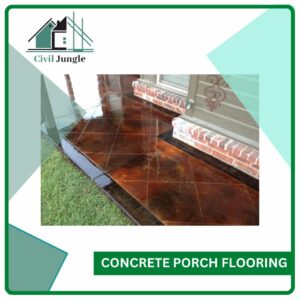
Concrete makes for an excellent porch flooring alternative. A porch with its traditional flooring has been a popular choice for at least a century.
There is a wide variety of options to choose from when working with concrete, which gives it a very modern, clean aesthetic. Most people just let the concrete age naturally and polish it with a trowel.
Concrete can be stained or stamped to provide a new appearance. Concrete can be given a textured appearance and feel with the help of additives that can be put on the surface as it dries.
Troweled finishes don’t require this texture, but we frequently employ it on stamps due to the surface’s tendency to become slippery when wet. Concrete can be stained and stamped to mimic the look of more expensive materials like stone, brick, or tile.
If your porch is exposed to the weather, whether it’s open or covered, concrete is a fantastic material choice. Make sure the porch is slanted away from the house and all cracks or gaps are fixed, just as you would if you were laying stone flooring over concrete.
While concrete porch flooring is more affordable than masonry, it still can’t compare to the cost of constructing a new front porch.
7. Modern Concrete Front Porch Flooring
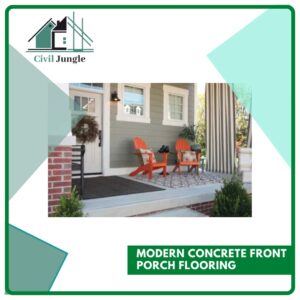
Concrete is a great choice for a front porch floor if you’re going for a more contemporary look. It can be left in its natural state, colored, molded, or stamped.
Concrete flooring is regarded as a flexible material due to the wide variety of alternatives available. Cast concrete is used for everything down to the wall tops.
The best material for a porch floor is unfinished or stamped concrete. It’s a fashionable, low-priced take on the contemporary appearance. Porch wall construction, footings, and backfill added a significant sum to the total price.
While more expensive materials like stone, composite decking, and even some types of wood are sometimes used for porch flooring, the concrete floor itself is quite inexpensive.
Additionally, I think the concrete might benefit from a little bit of texture. It’s possible to prevent the concrete from becoming a mud pit after a rainstorm by adding an addition to the mix before it’s poured. It’s important to avoid anything that could become dangerously slippery in the rain, as the porch is located outdoors.
Concrete’s ease of heating is another plus. In order to keep your concrete front porch toasty, you may install either an electric or hot water slab heating system.
These can’t be used on wood or composite decking, and due to the thickness of stone over concrete, they’re not a great fit for that surface either. Even without a concrete slab, it functions just as effectively with stone over compacted earth.
8. Red Brick Porch Flooring
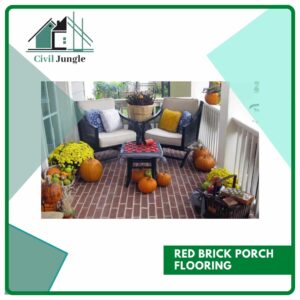
A brick floor is a timeless and elegant choice for a porch. Also, a personal favorite. I was raised in a city where every porch and step was constructed of brick, and I’ve always been a fan of the style.
They’re one of the few types of flooring that can compete with the warmth and allure that they provide. Not to mention, you may wear this style with many different looks. Brick flooring looks great in every style of the house, from Colonial to Ultra Modern. A classic material, brick never goes out of style.
The bricks are laid on top of a cement slab foundation. They are set individually in a cement bed and grouted. Brick flooring is not cheap because of the time and effort required to lay each individual brick.
A solid base is essential for laying bricks. You can’t build anything without a concrete foundation, brick walls, and a cement slab. If the foundation shifts, the mortar between the bricks and the wall will crack.
Because of the wide variety of brick types and colors available, brick may be used to create any desired aesthetic. Above, you can see the red, tumbling bricks used for the porch and the thick, white cement grout. It helps to create an authentic country feel on the porch.
Bricks can be found in several hues, some of which include tan, white, brown, and even red. It’s also worth noting that there’s a wide range of variation within each color. Not all red bricks are fire engine red; some are barely colored at all.
The flexibility of your porch floor can be further expanded by laying the bricks in a variety of designs. A common option is a herringbone.
Also Read: What Is Bamboo Flooring | Bamboo Flooring Pros and Cons
Porch Flooring and Foundation
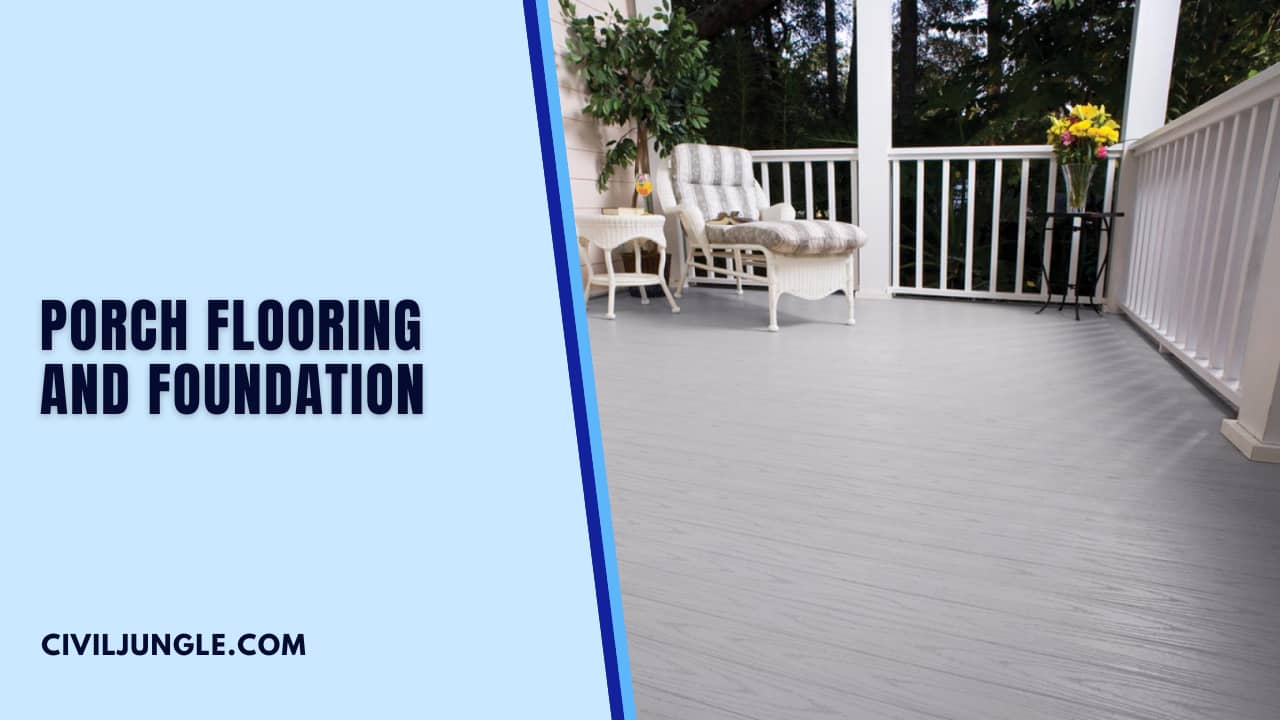
An excellent porch construction always begins with a firm footing. A porch is an extension of your home, therefore like the house itself, it needs to be built on a solid foundation.
The kind of porch base you’ll need depends on where you reside and where you plan to build. For instance, a home constructed on a steep incline typically needs foundation piers, which must be developed not only for porch load but also for local temperature, soil, and geologic conditions. These concerns need to be resolved before you choose and install a foundation for your porch.
Porch Flooring Planning Advice
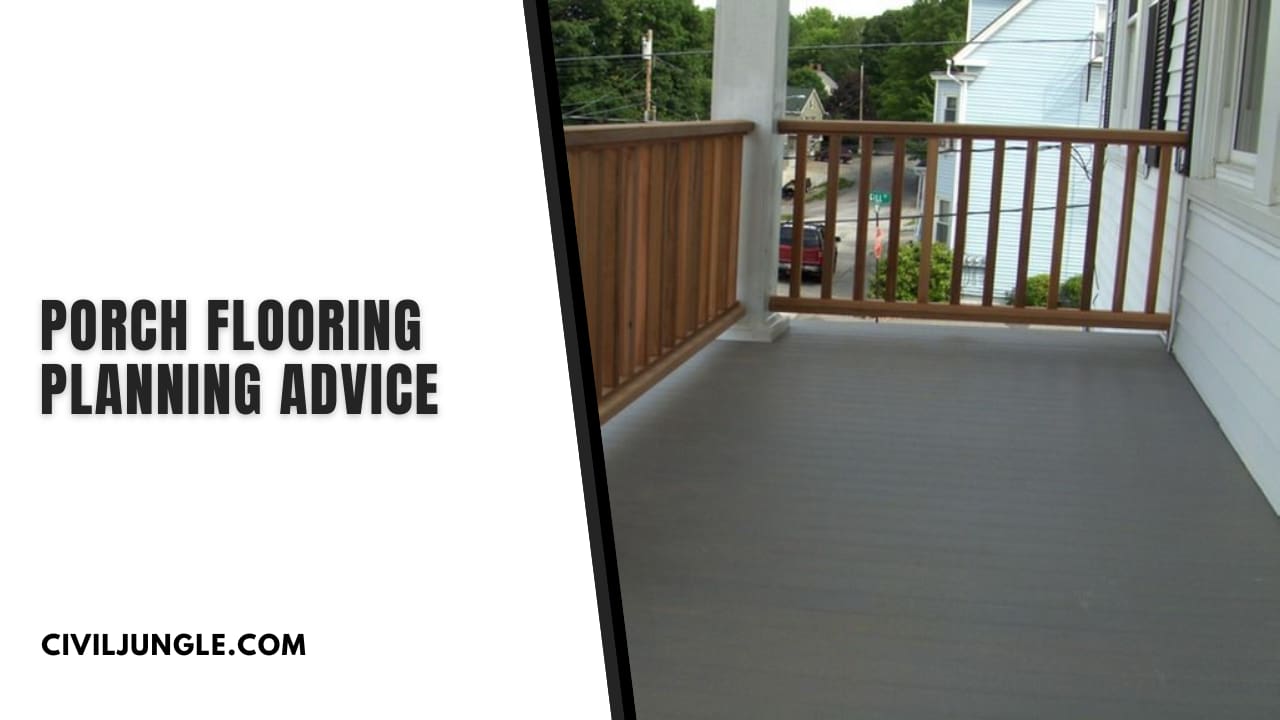
Create a gentle slope away from your porch to help keep water at bay. This is helpful for preventing mold and water damage to porch flooring caused by standing water.
To prevent mildew and rot from forming under your porch, use lattice skirting or decorative vents. The use of hardware cloth or mesh behind the lattice as rodent screening can be effective, depending on the height of your porch.
Prime all surfaces, including the cut edges, and install vents in the top and bottom of your porch’s columns and newel posts.
Porch Flooring Planning Advice for Flooring
Also crucial is the porch flooring you select. You’ll want a porch floor that can withstand the elements, looks good with your house, and serves as a stunning backdrop.
Wood, composite flooring and decking, brick, stone, concrete, and ceramic tile are all viable options for a porch that is exposed to the elements.
What you want your porch to look like, where you want to put it, and what kind of foundation you have all play a role in determining the best floor for your porch. Different materials have different benefits and drawbacks, so it’s important to find one that suits your porch’s needs.
Think about these factors while deciding on a patio floor:
- The conventional material for a porch floor is natural fir, but cedar, mahogany, and Brazilian Ipe are all viable substitutes.
- Mixing wood or placing boards in an interesting arrangement can give interest and texture to your porch floor.
- Follow the manufacturer’s directions when installing and caring for wood-free composite floors or composite tongue-and-groove flooring manufactured from wood fibers and plastic resins to ensure a long-lasting floor with a natural wood “appearance” that requires less upkeep.
- Water-resistant masonry floors, such as those made of brick, stone, or tile, are a popular option, but they can be heavy enough to require extra support on porches with a higher elevation.
- You can also use poured or pressed concrete. You can give your porch floor color or design by using high-quality paints made specifically for concrete.
Porch Flooring Planning Advice for Wood Porch
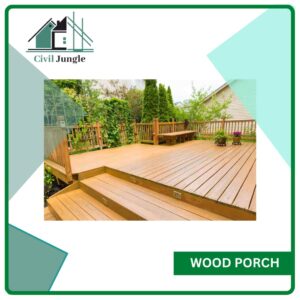
Most people, when they think of a porch, generally imagine it made of wood. It can be used for many purposes, is simple to manipulate, and is available in many forms.
Decking that has been pressure treated, for instance, is more resistant to the elements. Cedar and redwood, for example, have excellent natural weather resistance but are somewhat more expensive.
- Pros of the Wood Porch: As a material for porches, wood is common and cheap. Both its cosmetic and structural qualities are solid. Some people like the natural, unrefined aspect of wood, just as some people like the natural look of stone. You can paint it for a striking effect, or stain it to highlight the wood’s natural grain pattern.
- Cons of the Wood Porch: Wood decking is made from a natural resource but doesn’t always have a rustic appearance. Wood can warp and bend when exposed to weather, just like concrete can crack. Additionally, upkeep like sealing is required. Some homeowners are also uneasy with the presence of chemical preservatives in pressure-treated decking.
Porch Flooring Ideas
Here, the different porch flooring ideas are as follows.
Screen Porch Floor
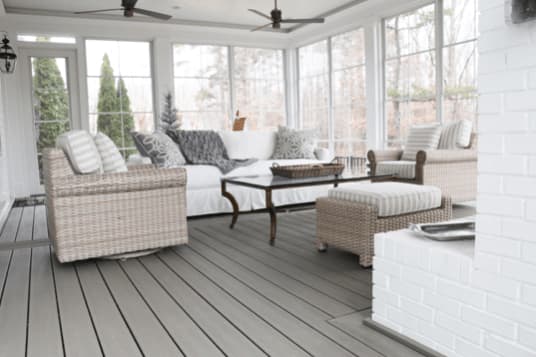
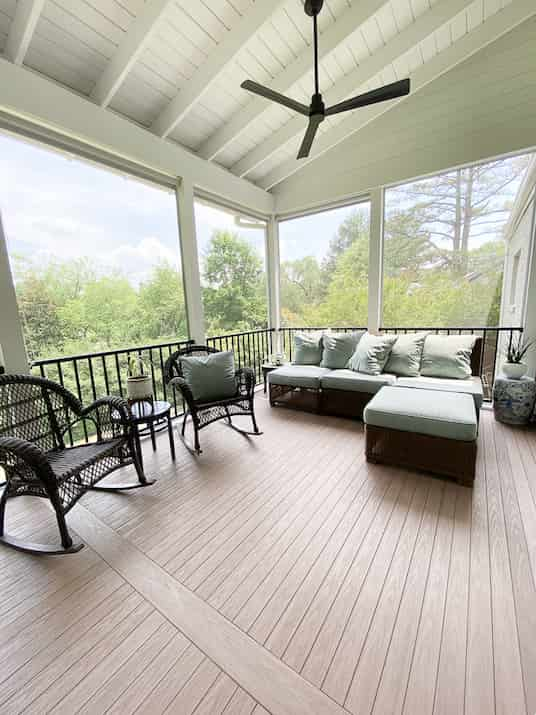
Brick Porch
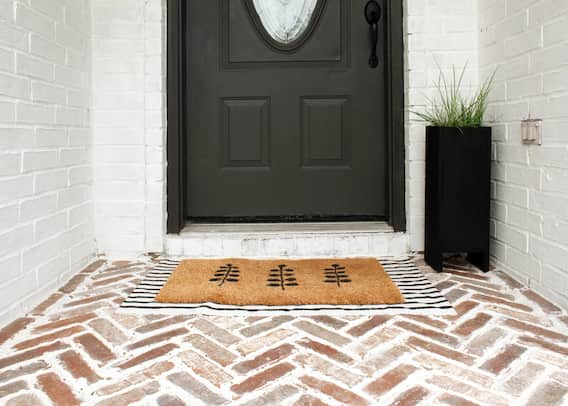
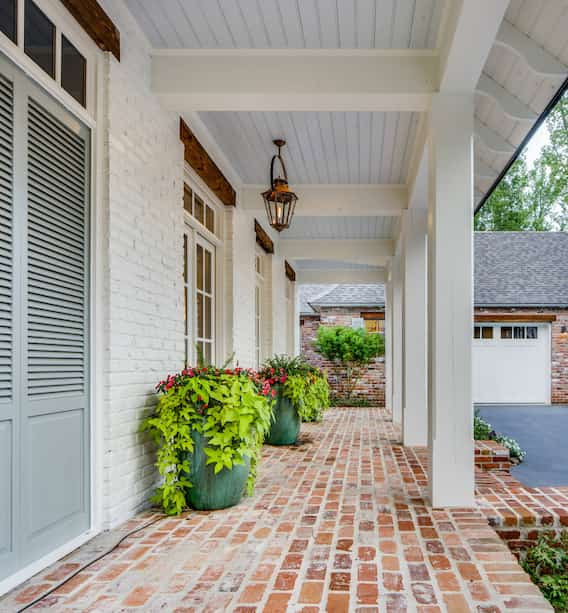
Front Porch Flooring Ideas Over Concrete

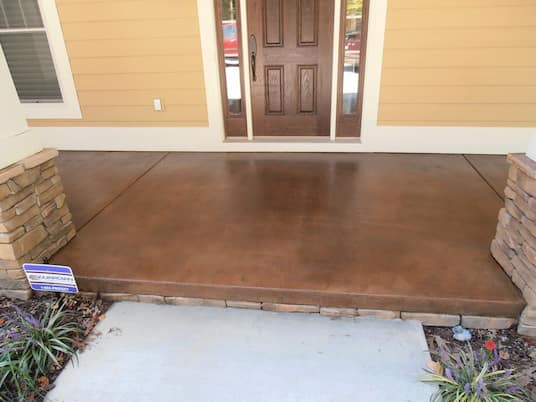
Patio Floor Covering

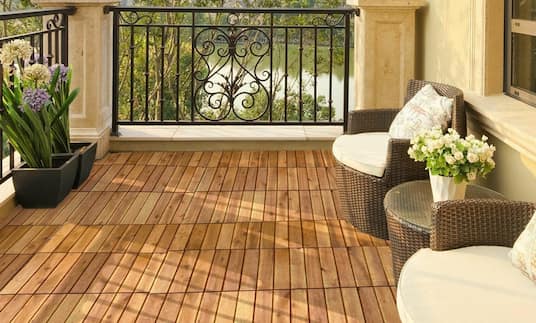
Outdoor Flooring Ideas
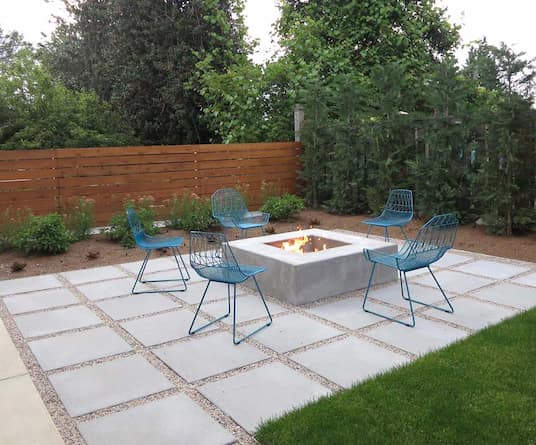
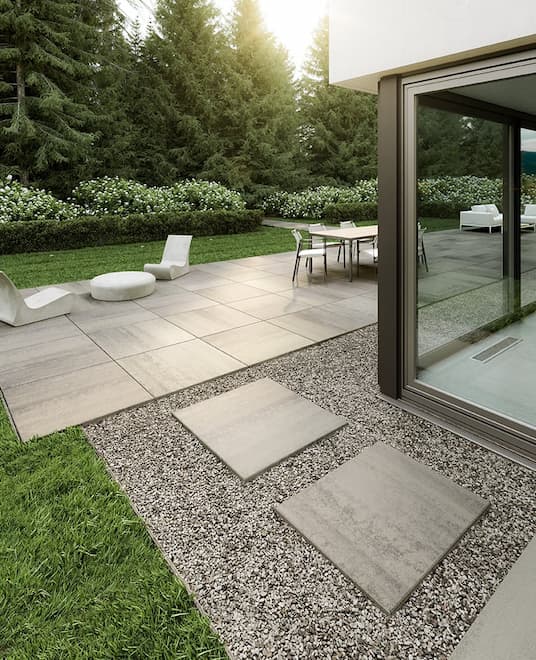
Wood Floor for Porch

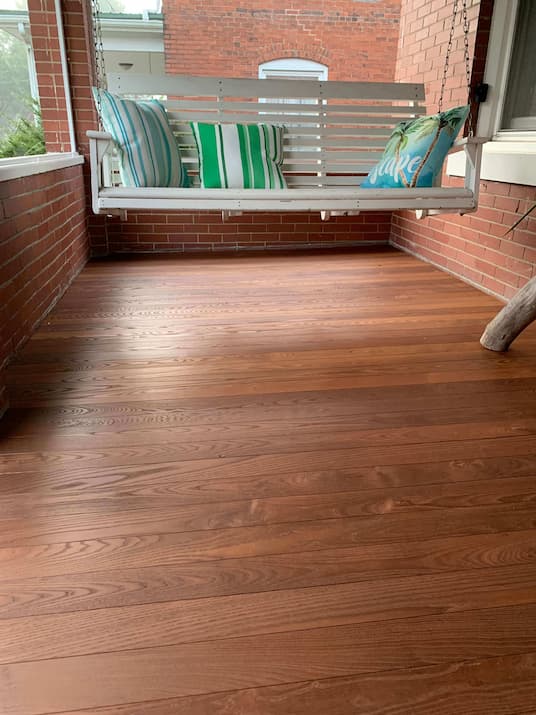
What Type of Flooring Is Best for a Porch?
While natural fir is the traditional choice for a porch floor, good wood alternatives include cedar, mahogany and Brazilian Ipe. You can add interest and texture to your porch floor by mixing woods or laying boards in a creative pattern.
What Is the Best Porch Flooring Over Concrete?
Vinyl flooring can closely resemble the look and feel of hardwood flooring while offering a low-maintenance surface. To sum it up – carpet, engineered hardwood, laminate, or vinyl flooring are all great options to install over a concrete substrate that can last for years when properly maintained.
How Can I Cover My Patio Floor Cheap?
In addition to the more expensive floor covering options such as concrete, bricks, and pavers, consider alternative cheap patio floor types such as gravel, mulch, seashells, or even decomposed granite.
What Is the Cheapest Outdoor Floor Cover?
The cheapest outdoor flooring is concrete patio flooring. Concrete enjoys a reputation as a cheap patio flooring option. Unlike other flooring materials, concrete slabs are budget-friendly.
What Is the Best Porch Flooring Over Concrete?
Vinyl flooring can closely resemble the look and feel of hardwood flooring while offering a low-maintenance surface. To sum it up – carpet, engineered hardwood, laminate, or vinyl flooring are all great options to install over a concrete substrate that can last for years when properly maintained.
What Can You Put on a Concrete Porch Floor?
Ceramic and porcelain tiles are great materials for re-surfacing a concrete porch. They will give you many decorative options based on a wide variety of colors and patterns available.
What Can You Put Over Concrete Front Porch?
Covering a concrete porch with wood provides a warmer, cozier feel. It is also a good way to cover up peeling paint, slight chipping and discolored concrete. Whatever your reasons, adding a wood floor to your concrete porch is a fairly simple operation.
Can You Put Flooring Over Concrete Porch?
Composite hardwood, vinyl, or laminate flooring are all great options over a concrete slab. These floors are all installed in sheets or pieces which makes installation easy for most DIYers.
How to Build a Porch Extension?
Here, the detail point of extending floor space ar as follows.
- Create a porch-extending patio by sinking concrete pavers or flagstones in the lawn adjacent to your porch.
- Drop pavers or stones close to each other on the lawn, allowing 1 to 2 inches between them for a grassy border.
- Rake the soil flat to make a shallow hole the same depth as the paver or stone.
How Much Does It Cost to Build a Brick Porch UK?
| Porch Type | Average Cost | Duration |
| Lean-to uPVC porch | £2,000-£3,000 | 1-2 weeks |
| Flat gable roof porch | £3,000-£4,000 | 1-2 weeks |
| Gable uPVC roof porch | £2,000-£3,000 | 1-2 weeks |
| Edwardian uPVC porch | £2,500-£3,500 | 1-2 weeks |
| Brick porch | £2,000-£3,000 | 1-2 weeks |
| Aluminium porch | £2,500-£3,500 | 3-5 days |
What Board to Use for Porch Sign?
Any kind of wood works. For my Fall Front Porch Sign, I used a scrap piece of cedar left over from our deck. It has a more rustic texture and appearance.
Can You Put Laminate in Screened in Porch?
Unfortunately, laminate flooring is not intended for outdoor use. There are some ‘weather-resistant’ laminates on the market, however most laminate floors are made strictly for indoor use. The flooring would warp and rapidly get damaged under changing weather conditions and would not last very long.
What Is the Best Flooring for a Screened Porch with Concrete Floor?
Choose outdoor tiles that have a slightly gritty surface to prevent slips and falls. Because they’re on a screened porch, the tiles will also be subject to heat and moisture, so it’s important to choose an exterior stone tile such as porcelain, granite or slate that can handle the elements.
What Kind of Flooring Is Best for Screened in Porch?
Carpet is popular flooring for screened in porches because of its noise absorption properties, minimal maintenance, and softness. Indoor/outdoor carpet can be purchased in many colors, textures, and patterns, and it is designed to resist moisture and UV rays.
Is Sealing Brick a Good Idea?
Most brick walls don’t need to be sealed as they include a cavity that allows water to drain from the bricks. Using sealant on bricks can trap water and moisture inside the bricks and cause damage. Most brick walls include cavities that allow water to drain from the bricks rather than using sealant.
How Do You Seal a Brick Porch?
Re-fill the joints between the bricks with new sand by pouring some sand on the patio. Sweep enough into the joints between the bricks to fill them back up. Using a pump-up garden type sprayer, apply two coats of water-based sealer to the patio.
How Do You Fix a Crumbling Brick Porch?
Crumbling and cracked bricks can be replaced with newer bricks and then sealed back into place. Additionally, deteriorating mortar can be replaced with tuckpointing removing damaged mortar and replacing it with fresh material
Outdoor Porch Flooring Options
There are plenty of flooring options for a typical porch partially exposed to the elements, including wood, composite flooring and decking, brick, stone, concrete and ceramic tile. The right floor for your porch depends on the type of foundation you have, the location of your porch and the look you want to achieve.
How Deep Do Footings Need to Be for a Porch?
Footing must be dug down into undisturbed soil and to a minimum depth of 12-in below the finished grade.
Like this post? Share it with your friends!
Suggested Read –
- Stone Joint
- Soft Flooring Options
- Vitrified Tiles Flooring
- What Is Dressed Stone
- Disadvantages of Epoxy Flooring
- Top 10 Tiles Companies in India 2023
- Top 15+ Best Plywood Brands in India 2023
- Top 10 Best Cement Companies In India 2023
- Building Estimation Step by Step In Excel Sheet
- All About Bathroom Wall Paneling Ideas | Top Bathroom Wall Paneling Ideas

